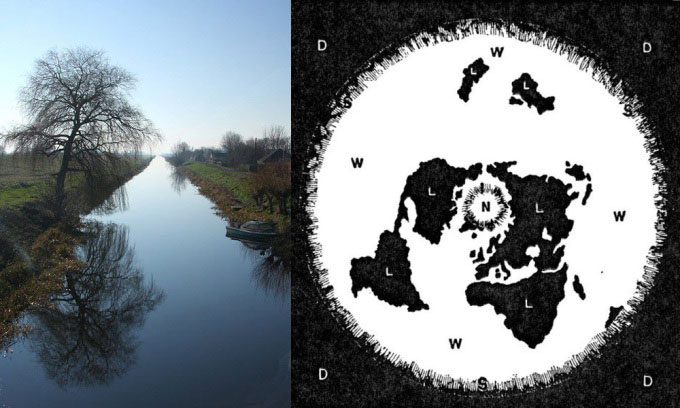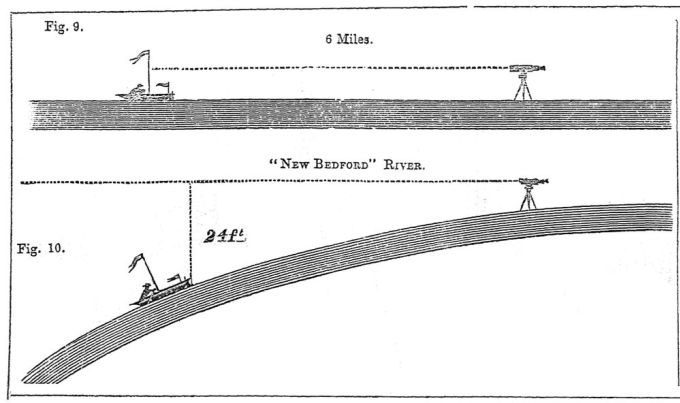Samuel Rowbotham, an English writer, conducted a series of experiments to support his belief in a flat Earth at the end of the 19th century. One of the most famous experiments he performed was the “Bedford Level Experiment”, conducted on a waterway called the Old Bedford River in Bedfordshire, England.
In 1838, English writer Samuel Rowbotham began to refute what both ancient Greeks and modern scientists had long asserted: The Earth is spherical. A proponent of the flat Earth theory since his youth, Rowbotham identified the ideal location to test this claim as the Old Bedford River in Welney. This artificial canal was constructed in the early 17th century to redirect a portion of the Great Ouse River in the Fens, Cambridgeshire, England. The canal runs completely straight and unobstructed for nearly 10 kilometers, making it an ideal site for directly measuring the curvature of the Earth.

Old Bedford River in Welney (left) and Rowbotham’s flat Earth map (right). (Photo: Amusing Planet/Bob Jones/Wikimedia Commons)
“The water is almost still – often completely still – and throughout its length, the canal is not interrupted by any type of lock or dam. Therefore, in every respect, it is suitable for determining whether any curvature exists,” Rowbotham wrote in his book Zetetic Astronomy.
Rowbotham waded into the river and used a telescope positioned 20 cm above the water’s surface to observe a boat slowly moving away. The boat had a pole with a flag attached, standing about 1 meter above the water. He claimed that the boat remained within his line of sight for the entire 10 km, while if the water were curved, the boat would have disappeared.
With this experimental evidence and a lengthy list of arguments, Rowbotham attempted to impose his flat Earth view on the community in Cambridgeshire. He published his observations in the Zetetic Astronomy in 1849, writing under the pseudonym “Parallax.” Rowbotham argued for a flat Earth based on everyday observations, such as the Earth not appearing curved from a balloon and lighthouses being visible at impossible distances if the Earth were spherical.
Rowbotham later expanded his views in the book Earth Not a Globe. The book claimed that the Earth is a flat disk with a center at the North Pole, surrounded by a wall of ice – Antarctica. Rowbotham even suggested that the Sun and Moon are only about 4,800 km away from the Earth, and that the “universe” is about 5,000 km from the Earth.

An illustration from Rowbotham’s Zetetic Astronomy published in 1849. (Photo: Amusing Planet)
Rowbotham’s claims did not attract much attention until 1870 when a supporter of the flat Earth hypothesis named John Hampden wagered £500 that he could prove the Earth was flat by repeating Rowbotham’s experiment. Naturalist and surveyor Alfred Russel Wallace accepted the bet.
Wallace knew that changes in air density just above the water’s surface could cause light to bend toward the ground, allowing an observer to see objects beyond the horizon. To demonstrate the curvature of the Earth, Wallace placed a series of disks on poles along the waterway. When viewed from one end, the disks pointing toward the center of the canal appeared slightly higher than the others, while the disks at the far end looked a bit lower. Thus, with his knowledge of physics, he avoided the errors of previous experiments and won the bet.
Despite the evidence, Hampden adamantly refused to acknowledge Wallace’s demonstration. However, the referee John Henry Walsh, editor of the sports magazine The Field, demanded Hampden pay the wager to his opponent. Although Hampden complied with the betting agreement, he subsequently harassed, threatened, and defamed Wallace.
Meanwhile, Rowbotham continued to develop his ideas. He died in 1884, but the flat Earth perspective persisted. His work in the United States was continued by printer William Carpenter.
Carpenter published the book Theoretical Astronomy Examined and Exposed – Proving the Earth Not a Globe in 1864, consisting of eight parts. He then emigrated to Baltimore and continued publishing One Hundred Proofs the Earth Is Not a Globe in 1885, writing many falsehoods.
In 1904, British writer and social activist Elizabeth Blount repeated Rowbotham’s famous Bedford experiment with similar results. She hired a photographer with a telephoto lens to capture a large white cloth placed near the surface of the canal at Rowbotham’s original position 10 km away.
After positioning the camera at a height of 60 cm above the water at Welney, the photographer was astonished to capture the target, which he believed should have been impossible to see due to the low camera position. As with Rowbotham’s case, Blount did not account for the effects of atmospheric refraction. However, the photographer did notice an illusion he described as “a hazy layer of water vapor that appeared to float unevenly above the surface of the canal.”
In 1956, preacher Samuel Shenton founded the Flat Earth Society. Shenton passed away in 1971, but the society he established continued to thrive, reaching 3,500 members three decades later. The advent of the Internet and the popularity of social media contributed to its growth. The number of flat Earth proponents today may even reach into the millions.


















































